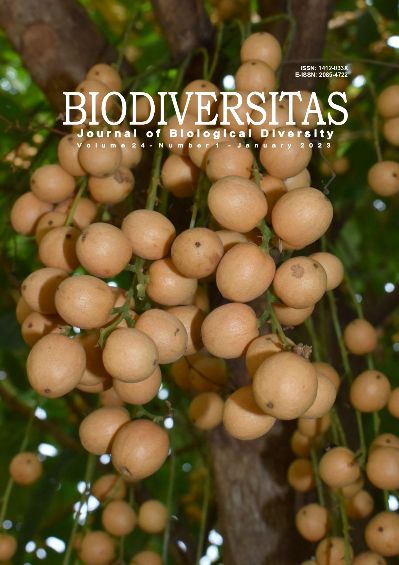Isolation and molecular identification of agarwood-inducing fungi and their virulence test using Aquilaria sp. seedlings
##plugins.themes.bootstrap3.article.main##
Abstract
Abstract. Lukman, Dinarti D, Siregar UJ, Turjaman M, Sudarsono. 2023. Isolation and molecular identification of agarwood-inducing fungi and their virulence test using Aquilaria sp. seedlings. Biodiversitas 24: 140-148. Agarwood is a lump of fragrant resin with a dark color and distinctive aroma from secondary metabolite products that accumulate in wood fibers produced from the genus Aquilaria and Gyrinops, a plant defense mechanism against damage caused by wounds and infection of specific fungal pathogens. The three main factors in producing agarwood sapwood are the presence of plants that have the potential to produce agarwood (family Thymelaceae) as a host, a supportive environment, and the presence of specific fungal pathogens. The isolation, identification, and virulence testing of local isolates must be made to get the correct agarwood-inducing pathogens without posing potential environmental problems. A total of five explants of Aquilaria sp. branches producing agarwood from the study site were used. This study aims to isolate local strains of fungi associated with agarwood formation from North Aceh regency, Aceh province, Indonesia, figure out their virulence against and ability to induce agarwood from seedlings of target trees, and determine their species identity. The experiments comprised isolation, macroscopic and microscopic identification, virulence tests, and species identification based on ITS sequences. The study resulted in five local Aceh isolates (LAI-1- LAI-5). Four isolates (LAI-1 - LAI-4) can induce agarwood formation, and oneisolate (LAI-5) is a white rot fungus. The ITS sequence analysis showed that LAI-1 - LAI-4 were Fusarium solani, while two colonies taken from LAI-5 isolate were identified as Ceriporia lacerataor Irpex laceratus (LAI-5 colony#1), and Daldinia eschscholtzii (LAI-5 colony #3). Based on these findings, the LA-5 isolate was probably a mixture of the two white rot fungus isolates.

